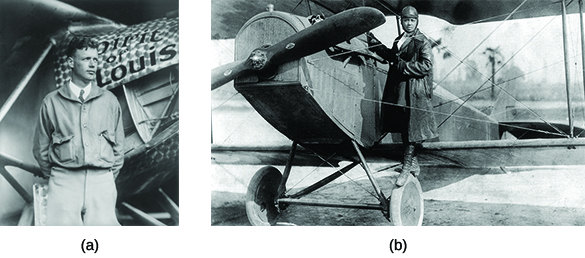| << Chapter < Page | Chapter >> Page > |
The automobile changed the face of America, both economically and socially. Industries like glass, steel, and rubber processing expanded to keep up with auto production. The oil industry in California, Oklahoma, and Texas expanded, as Americans’ reliance on oil increased and the nation transitioned from a coal-based economy to one driven by petroleum. The need for public roadways required local and state governments to fund a dramatic expansion of infrastructure, which permitted motels and restaurants to spring up and offer new services to millions of newly mobile Americans with cash to spend. With this new infrastructure, new shopping and living patterns emerged, and streetcar suburbs gave way to automobile suburbs as private automobile traffic on public roads began to replace mass transit on trains and trolleys.
The 1920s not only witnessed a transformation in ground transportation but also major changes in air travel. By the mid-1920s, men—as well as some pioneering women like the African American stunt pilot Bessie Coleman ( [link] )—had been flying for two decades. But there remained doubts about the suitability of airplanes for long-distance travel. Orville Wright, one of the pioneers of airplane technology in the United States, once famously declared, “No flying machine will ever fly from New York to Paris [because] no known motor can run at the requisite speed for four days without stopping.” However, in 1927, this skepticism was finally put to rest when Charles Lindbergh became the first person to fly solo across the Atlantic Ocean, flying from New York to Paris in thirty-three hours ( [link] ).

Lindbergh’s flight made him an international hero: the best-known American in the world. On his return, Americans greeted him with a ticker-tape parade—a celebration in which shredded paper thrown from surrounding buildings creates a festive, flurry effect. His flight, which he completed in the monoplane Spirit of St. Louis , seemed like a triumph of individualism in modern mass society and exemplified Americans’ ability to conquer the air with new technology. Following his success, the small airline industry began to blossom, fully coming into its own in the 1930s, as companies like Boeing and Ford developed airplanes designed specifically for passenger air transport. As technologies in engine and passenger compartment design improved, air travel became more popular. In 1934, the number of U.S. domestic air passengers was just over 450,000 annually. By the end of the decade, that number had increased to nearly two million.
Technological innovation influenced more than just transportation. As access to electricity became more common and the electric motor was made more efficient, inventors began to churn out new and more complex household appliances. Newly developed innovations like radios, phonographs, vacuum cleaners, washing machines, and refrigerators emerged on the market during this period. While expensive, new consumer-purchasing innovations like store credit and installment plans made them available to a larger segment of the population. Many of these devices promised to give women—who continued to have primary responsibility for housework—more opportunities to step out of the home and expand their horizons. Ironically, however, these labor-saving devices tended to increase the workload for women by raising the standards of domestic work. With the aid of these tools, women ended up cleaning more frequently, washing more often, and cooking more elaborate meals rather than gaining spare time.

Notification Switch
Would you like to follow the 'U.s. history' conversation and receive update notifications?